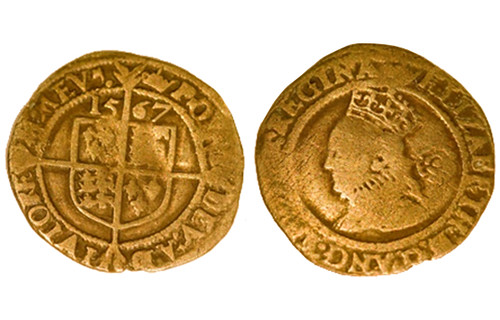
PREV ARTICLE
NEXT ARTICLE
FULL ISSUE
PREV FULL ISSUE
ARTICLE ADDRESSES METAL ORE 'FINGERPRINTS' IN COINAGE
Dick Johnson submitted these thoughts inspired by an article that verifies that certain English coins were made of silver from Mexico. Thanks!
-Editor
 A coin struck during the reign of England’s Elizabeth I (1558–1603)
A coin struck during the reign of England’s Elizabeth I (1558–1603)
Nature has buried a lot of clues in the world if man would only learn how to read them. That is the case with ores buried underground -- and the resulting metal made from those ores -- and the products made from that metal. Man is learning more and more how to read the "fingerprints" of metal ores. The miniscule metal impurities, found in all metal, reveal a distinctive pattern. From the measurements of these impurities, now easily obtained by modern laboratory equipment, lock in the identity of metal ore from any location. These manifestly stay in the metal through all forms of manufacture, fabrication, or movement around the globe and last for all time. Thus scholars have analyzed ancient coins by chemical analysis of their metal to gain intelligence on where the metal came from. Scholars are building a databank of the impurity fingerprints of the metal from each original mine. Gold is a little more obvious in its impurity identity by slight differences in color, unlike other metals. Slight amounts of silver or platinum will make a whiter gold. Copper makes gold reddish or pinkish. Iron turns gold greenish. And it was learned that it was bismuth that made a natural "black gold." All from those miniscule impurities. We can tell which early American coins were made from blanks obtained from Mathew Boulton; he obtain his metal from Sweden's "copper mountain" in the 18th century. This in contrast to the copper colonial mints obtained from early Connecticut mines. An article appeared this week that verifies that certain English coins were made of silver from Mexico.
Here's an excerpt from the Science News article.
-Editor
Chemical studies of old English coins are helping unravel a centuries-old mystery: What happened to all the silver that Spaniards dug out of the New World? Silver from Mexican mines started being incorporated into English coins around the mid-1550s, a new study shows. But silver from the legendary Potosí mines, in what is now Bolivia, didn't show up until nearly a century later, researchers report online November 6 in Geology. The new study adds hard data to theories linking the transatlantic influx of silver to price inflation across Europe from about 1515 to 1650. Minerals such as gold and silver contain a chemical fingerprint of where they were born, for instance in the composition of copper and lead that appear along with the more precious metals. Anne-Marie Desaulty and Francis Albarède of the Ecole Normale Supérieure in Lyon, France, analyzed 15 English coins, dated between 1317 and 1640, for variations in their copper, lead and silver. Lead in all the coins before the reign of Mary I, which began in 1553, showed that the ore was at least 220 million years old, suggesting it came from ancient rocks in either central Europe or England. Lead in later coins showed a much higher contribution of silver younger than 50 million years old - suggesting it came instead from the mines of Mexico. The coins show very little hint of Potosí silver, which has a distinctly different lead signature than Mexican ore. That's surprising, Desaulty says, because the Potosí mines were churning out far more silver at the time than Mexico was. Geography may explain this, she says: It was easier to ship Mexican silver eastward to Europe than to get Potosí silver across the breadth of Brazil. Instead, Potosí silver went west, from Lima to Acapulco and onward to markets in China. Scholars have known of this westward trade route before, which probably didn't become really important until the early 17th century, says John Munro, an economist at the University of Toronto.
To read the complete article, see:
Mexican silver made it into English coins
(www.sciencenews.org/view/generic/id/346607/title/Mexican The Numismatic Bibliomania Society is a non-profit organization promoting numismatic literature. See our web site at coinbooks.org. To submit items for publication in The E-Sylum, write to the Editor at this address: whomren@gmail.com To subscribe go to: https://my.binhost.com/lists/listinfo/esylum All Rights Reserved. NBS Home Page Contact the NBS webmaster 
|